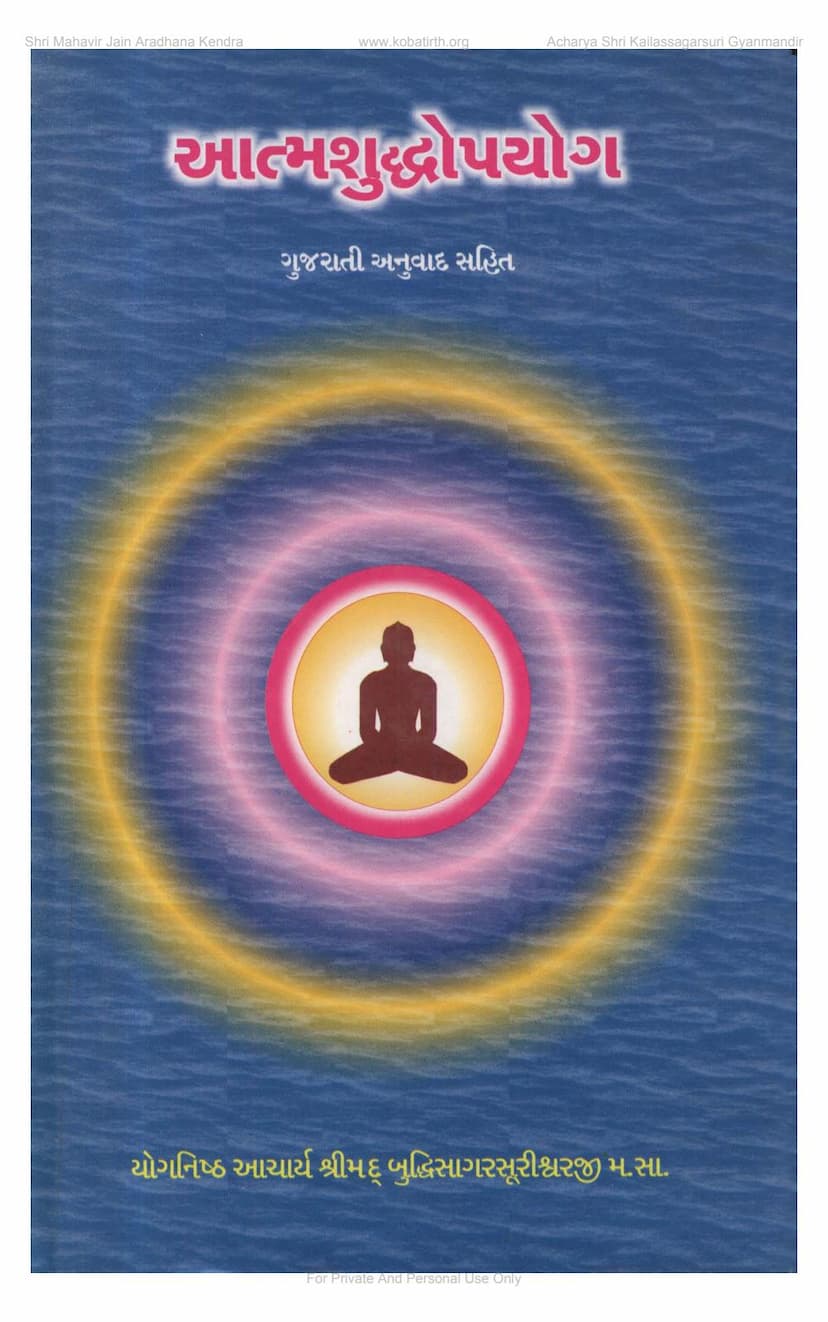Atmashuddhipayog Anuwad
Added to library: September 1, 2025

Summary
Here's a comprehensive summary of the Jain text "Atmashuddhipayog Anuwad" by Buddhisagar, based on the provided pages:
Title: Atmashuddhipayog Anuwad (Translation of Atmashuddhopayog) Author: Yognishta Acharya Shrimad Buddhisagar Surishwarji Maharaj Publisher: Shrimad Buddhisagar Suri Jain Samadhi Mandir, Vijapur
Overall Theme:
The book "Atmashuddhipayog Anuwad" is a Gujarati translation and commentary on the spiritual principles of achieving pure consciousness and self-purification through focused meditative practices, central to Jain philosophy. It emphasizes the path to liberation (moksha) through understanding and cultivating "Atma Shuddhopayog" (pure self-consciousness or right concentration).
Key Concepts and Teachings:
- The Nature of the Soul (Atma): The text describes the soul as eternal, pure, blissful, and intrinsically perfect, existing beyond birth, death, old age, and suffering. It is free from all impurities and attachments. The soul is the true self, distinct from the body and material possessions.
- The Goal of Life: The ultimate aim of life is to realize the true nature of the soul and achieve liberation from the cycle of birth and death (samsara). This is achieved by eradicating karmic impurities and attaining a state of pure, blissful consciousness.
- "Atma Shuddhopayog" (Pure Self-Consciousness): This is the central concept. It refers to the state of being fully absorbed in one's own true self, characterized by equanimity, detachment, and spiritual awareness. This state is considered the highest form of meditation and the direct path to liberation.
- The Role of Right Faith, Knowledge, and Conduct (Ratnatrayi): The text highlights the importance of the "three jewels" of Jainism – Samyak Darshan (Right Faith), Samyak Gyan (Right Knowledge), and Samyak Charitra (Right Conduct) – as the foundation for achieving Atma Shuddhopayog.
- Detachment from Worldly Pleasures: The book strongly advocates for renouncing attachment to sensory pleasures, worldly possessions, reputation, and relationships. These are considered transient and ultimately lead to suffering. The text likens worldly pleasures to dreams and warns against their illusionary nature.
- The Nature of Karma: It explains that karma binds the soul and causes suffering. However, through pure self-consciousness and right conduct, karmic bondage can be dissolved, leading to liberation.
- Meditation and Self-Control: Various forms of meditation, self-control (samyam), and mindful awareness are presented as essential tools for purifying the mind and achieving Atma Shuddhopayog.
- The Importance of Equanimity (Samata): Maintaining an equanimous state of mind, unaffected by dualities like pleasure and pain, praise and blame, gain and loss, is crucial for spiritual progress.
- The Supremacy of Spiritual Practice: The text stresses that external rituals or actions alone are insufficient. The internal state of consciousness, achieved through Atma Shuddhopayog, is paramount.
- The Path to Liberation: The book outlines that by consistently practicing Atma Shuddhopayog, one can gradually shed karmic impurities, realize the soul's true nature, and ultimately attain moksha. This involves a constant focus on the self, detachment from the external world, and cultivating inner peace.
- The Teachings of Mahavira and other Tirthankaras: The text refers to Lord Mahavir and the principles of Jainism as the ultimate guide to achieving this spiritual state. It suggests that the essence of all religions lies in realizing the pure self.
- The Role of the Guru: The importance of a spiritual guide (Sadguru) in the journey towards self-realization is acknowledged, emphasizing that their grace and teachings are instrumental in dispelling ignorance and attaining true knowledge.
- The Equivalence of Spiritual Paths: The text suggests that liberation is attainable through various paths and practices, but the underlying essence is the cultivation of pure self-consciousness, irrespective of one's external religious affiliation or social standing.
- The Power of Self-Effort: While acknowledging external factors like the guru, the ultimate responsibility for liberation rests on individual effort and the consistent practice of Atma Shuddhopayog.
Structure and Content:
The book appears to be a collection of verses or aphorisms (shlokas) compiled by Acharya Buddhisagar, expounding on the path of self-purification and liberation. The pages provided showcase a progression of these teachings, starting with foundational principles and delving into the practical aspects of achieving Atma Shuddhopayog. The extensive list of shlokas (numbered up to 806) suggests a detailed exploration of the topic.
In essence, "Atmashuddhipayog Anuwad" serves as a profound guide for spiritual seekers within the Jain tradition, illuminating the path to self-realization and ultimate freedom through the diligent cultivation of pure, unwavering consciousness.